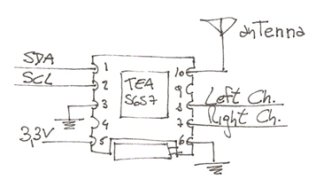Summary of Making an FM radio-Part 1; the TEA5767
This project involves building a small FM radio using a low-cost TEA5767 module controlled by an MSP430 microcontroller. The TEA5767 chip offers electronically tuned FM stereo reception with integrated IF selectivity and demodulation, operating via I2C communication. The setup includes controlling station selection through an encoder and volume via a potentiometer. The module operates at 3.3V and uses specific pins for I2C (SDA and SCL), power, audio output, and antenna connection.
Parts used in the FM Radio Project:
- TEA5767 FM radio module with Phillips chip
- MSP430 microcontroller
- Rotary encoder (for station tuning)
- Potentiometer (for volume control)
- 3.3V power supply
- External antenna (a piece of wire)
I’ve started to build a little FM radio with one of this cheap modules with a Phillip chip, the TEA5767. I will control it with a MSP430, probably I’ll use some kind of encoder to change stations and a potentiometer for the volume.
The TEA5767 is a single-chip electronically tuned FM stereo radio for low-voltage applications with fully integrated Intermediate Frequency (IF) selectivity and demodulation.Most of the information of this devices is from the datasheet and this app note.
The I2C-bus mode is selected when pin BUSMODE (PIN 3) is LOW. The serial interface use pin 1 as SDA and PIN 2 as SCL. The board is powered with 3.3V with VCC being PIN 5 and GND in PIN 6. PIN 10 is there to connect an external antenna (just a piece of wire) and PIN 7 and 8 are the audio outputs. Pins 4 and 9 are left unconnected.
First of all let me explain some basics concepts about FM radio receivers in order to understand how to configure the different settings this chip has. I might be oversimplifying some things here, I’m just writing what I’ve read and understood while searching information to use this thing so beware of mistakes!
For more detaiL: Making an FM radio-Part 1; the TEA5767

